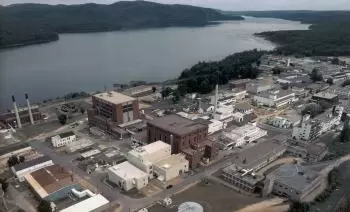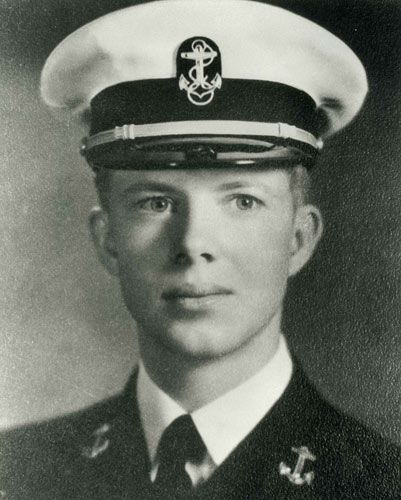
The Chalk River suffered two nuclear accidents in 1952 and 1957 at the Chalk River Laboratories.
Chalk River Laboratories is a facility located in Ontario, Canada. During the 1950s, these facilities suffered two major nuclear accidents.
The first Chalk River nuclear disaster occurred in 1952 when the NRX reactor suffered an explosion that destroyed the reactor core. The explosion of the reactor caused the fusion of nuclear fuel. The descent of the control rods failed, so the chain nuclear fission reactions could not be stopped. As a result, thousands of radioactive particles were released into the atmosphere.
The second nuclear accident at the Chalk River facility took place five years later. In this case, several uranium nuclear fuel rods overheated and broke in the core of the NRU reactor. Due to the rupture of the fuel rods, they caught fire, causing severe consequences for the Canadian facility.
What are the Chalk River Laboratories?
The Chalk River Laboratories are facilities located near the town of Chalk River, Ontario (Canada). It was dedicated to the investigation of nuclear reactions.
The facility was born in 1942 due to collaboration between British and Canadian nuclear researchers in the context of the Second World War. The Chalk River Laboratories were opened in 1944, and in September 1945, the facility put the first nuclear reactor outside the United States into operation.
The NRX is a research nuclear reactor moderated by heavy water, cooled by light water. Although the designers considered many other civil applications, it was built in wartime for military purposes. Today the Chalk River Laboratories are of great importance in the medical applications of nuclear energy.
Atomic Energy of Canada Limited’s role
In 1952, the government created Atomic Energy of Canada Limited (AECL) to promote the peaceful use of nuclear energy. AECL also took over the Chalk River operation from the NRC.
First Chalk River’s nuclear accident (1952)
The first accident occurred on December 12, 1952. The NRX reactor suffered a shutdown failure. This failure, along with several poor decisions by facility operators, caused a nuclear fission chain reaction that more than doubled the power of the atomic reactor.
Operators opened the four pressure containment valves in the cooling system of the nuclear power facility. As a result, it caused an explosion that destroyed the nuclear reactor core, causing an atomic fuel spill.
The closure of the control rods did not drop entirely into the reactor core for some reason. Thus, a series of hydrogen gas explosions (or steam explosions) launched the four-ton dome through the air.
Thousands of nuclear fission particles were released into the atmosphere and a million liters of radioactively contaminated water. The contaminated water had to be pumped out of the basement and dumped into shallow ditches near the Ottawa River.
The core of the NRX reactor could not be decontaminated but had to be buried as a significant level of radioactive waste. In its place, a new nuclear reactor, even more powerful, was placed to continue its operation.
What role did Jimmy Carter play in the Chalk River disaster?
 Out of curiosity, a young Jimmy Carter was one of the hundreds of Canadian and American military personnel who were ordered to participate in NRX cleanup. At that time, he was a U.S. Navy nuclear engineer. Later he would be president of the USA.
Out of curiosity, a young Jimmy Carter was one of the hundreds of Canadian and American military personnel who were ordered to participate in NRX cleanup. At that time, he was a U.S. Navy nuclear engineer. Later he would be president of the USA.
At that time, the INES Scale (International Nuclear Events Scale) had not yet been created. However, nowadays, taking into account its effects, it would be at level 5 of the INES scale (accident with risk off-site).
Second Chalk’s River accident (1958)
Five years later, in 1958, several metal uranium nuclear fuel rods from the NRU reactor overheated. As a result, they broke inside the reactor core. One of the damaged bars caught fire and split in two while being removed from the base by a robotic crane. It fell into shallow maintenance well.
The burning of nuclear fuel was left there, spreading toxic atomic fission products and the emission of alpha particles throughout the Chalk River reactor building. In addition, the ventilation system was clogged in the "open" position. Thus, it drove the spread of contaminated particles to the building's access areas, as well as a significant downwind area at the reactor site.
A relay team of scientists and technicians finally extinguished the fire. More than a thousand men were involved in cleanup operations after these two accidents on the Chalk River.
Heavy water leakage (2008 and 2009)
In December 2008 and May 2009, small amounts of heavy water containing tritium leaked into the NRU reactor.
The quantities were not significant and did not pose any danger to the environment. In 2008, it was 47 liters and, in 2009, about 5 liters per hour. The leakage was caused by corrosion of the reactor vessel.
The reactor was shut down and repaired in 2009 to prevent further leakage. All fuel and water were removed, and the reactor was restarted in August 2010. Since the NRU reactor is responsible for 40% of the worldwide production of radioactive isotopes, a significant shortage of these isotopes arose during the repair of the reactor.
What were the consequences of the Chalk River nuclear accidents?
More than 600 men were needed just to clean up the NRU. The official reports of the AECL highlight that very few of these men were exposed to excessive radiation. According to them, most of the registered doses of radioactivity did not exceed the acceptable levels considered for workers at nuclear facilities right now.
The reports also indicated that there were no adverse health effects caused by the radiation exposure received.
However, no medical follow-up has been done to see if the population of men involved in the future Chalk River accidents showed a higher than average cancer incidence.
Temporary closure in 2007
Under the permit granted in 2006, the NRU reactor was shut down for routine maintenance on November 18, 2007.
In consultation with the Canadian Nuclear Safety Commission (CNSC), it was decided to add additional earthquake-resistant power supplies to the installation on top of the emergency power supplies already in place. CNSC was in charge of monitoring Canada's nuclear installations
The closure led to a worldwide shortage of radioisotopes for medical applications. For example, Chalk River produces two-thirds of all technetium-99.
On December 11, 2007, Canada's lower house passed an emergency law authorizing the NRU reactor to restart for 120 days. However, it was against the decision of the CNSC. This bill was ratified by the Senate and received royal assent on December 12, 2007.
Prime Minister Stephen Harper strongly criticized the CNSC. Moreover, he considered that CNSC was endangering the lives and safety of tens of thousands of Canadians. He said there was no danger, contrary to the testimony of CNSC chairman and director Linda Keen.
Finally, she was fired for two reasons: firstly, for ignoring Parliament's decision to return the reactor to service. And secondly, for failing to consider the interests of citizens in the decision to extend safety features at the reactor.
The NRU reactor was put back into operation on December 16, 2007. The prolonged closure of the reactor prompted the development of other and safer methods for producing medical isotopes.